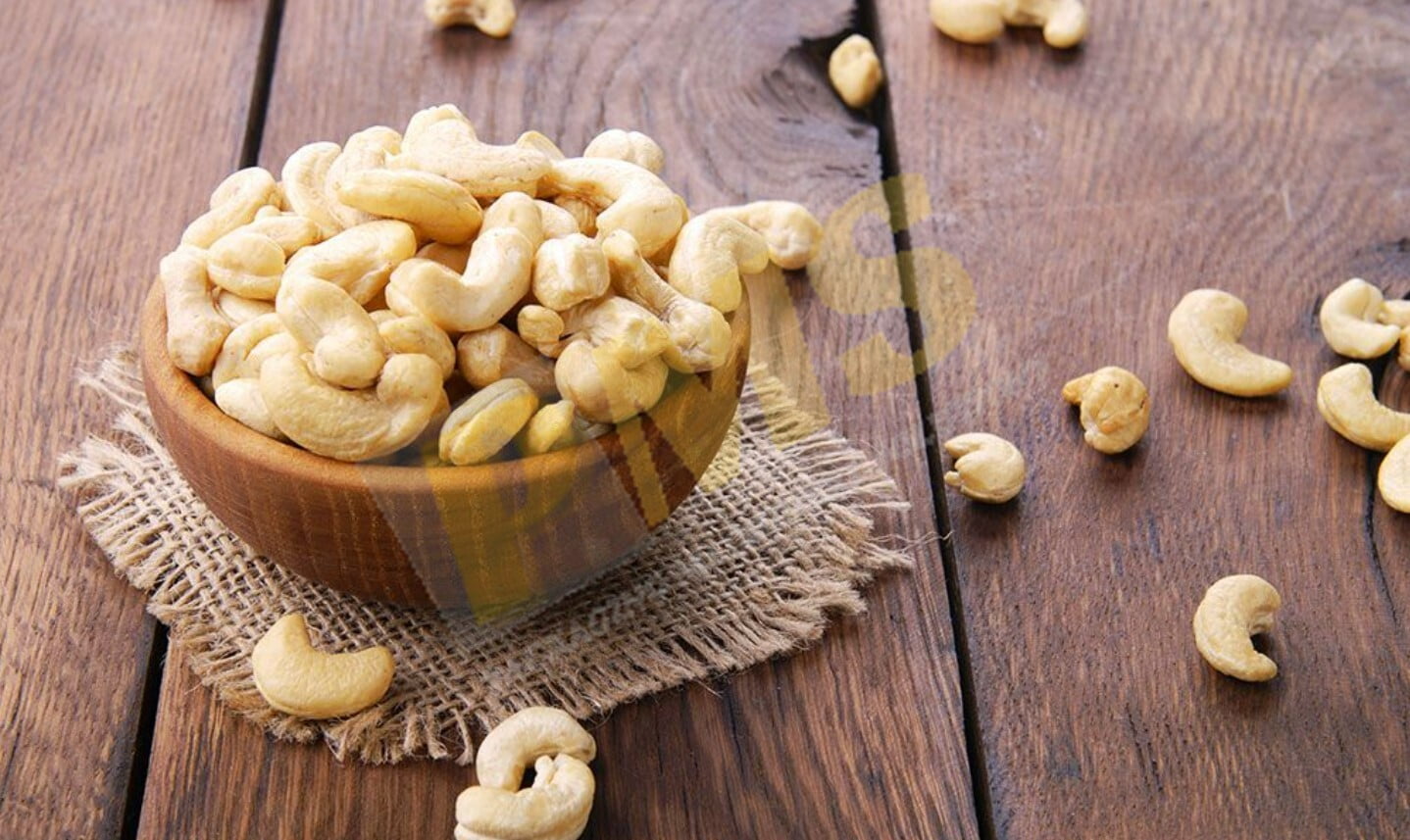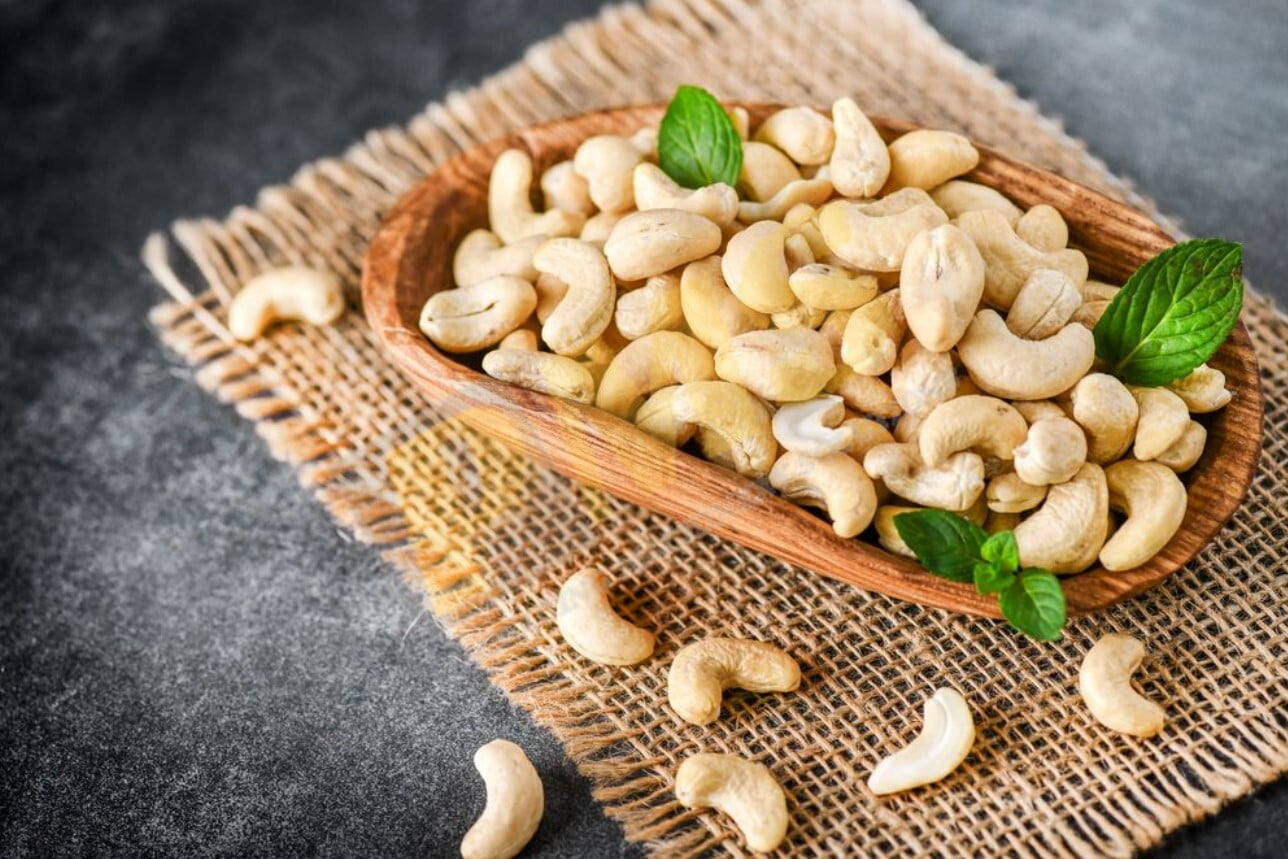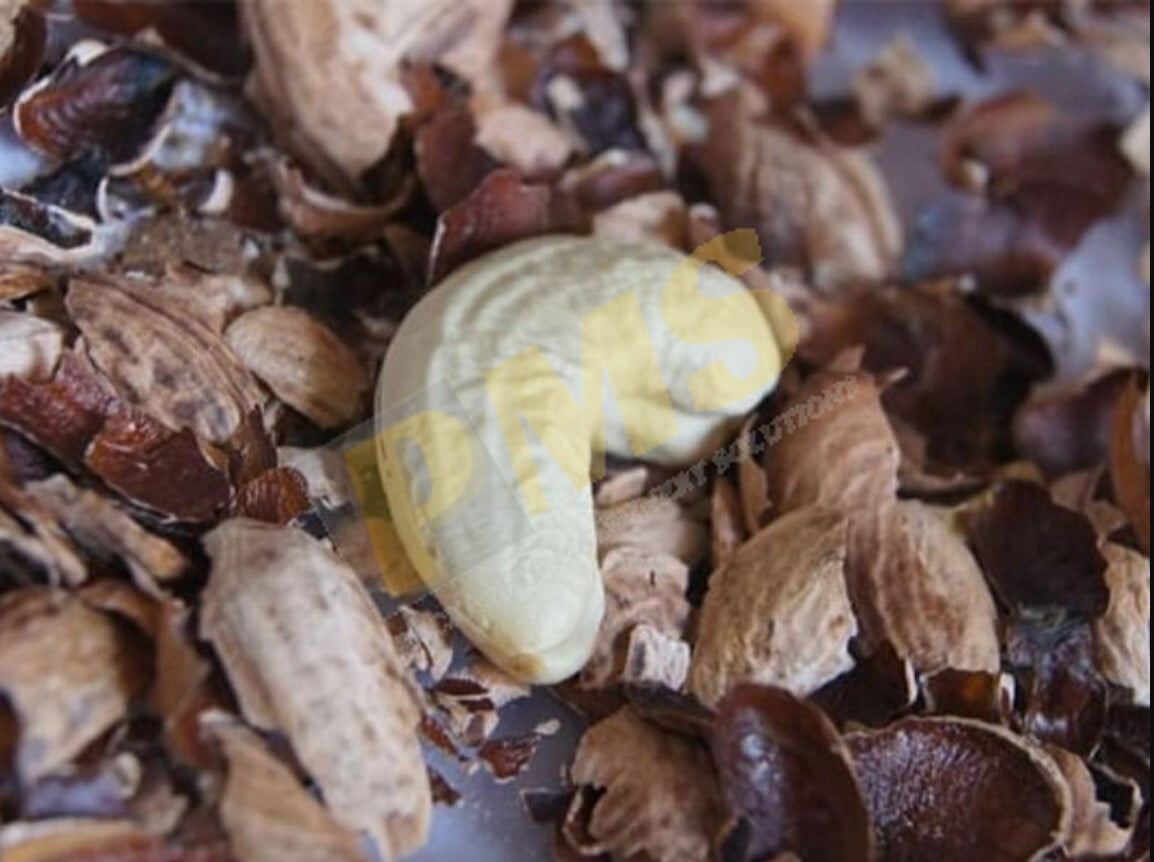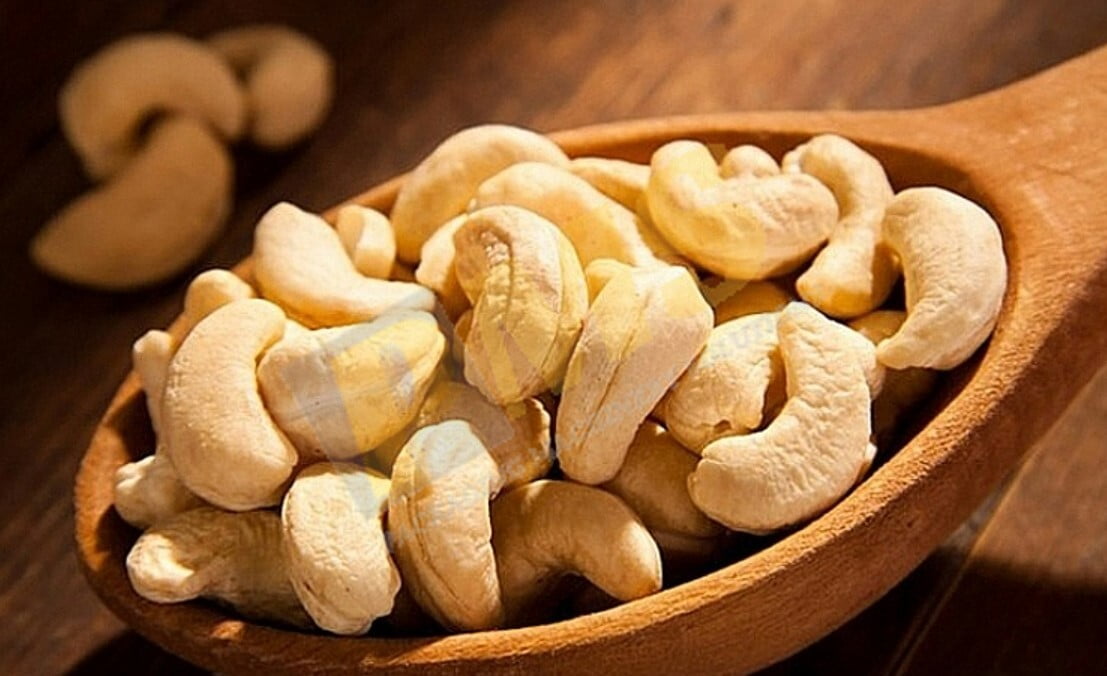Step 1: Check the quality of the input materials
The input materials are checked to ensure that the raw cashew nuts meet the standards before processing.
Method: When purchasing raw materials, the sensory quality must be checked. In addition, it is necessary to consider: Check the moisture content of the raw cashew nuts and the number of nuts in 1 kilogram
Step 2: Drying and storing raw cashew nuts
Drying – Storing raw cashew nuts reduces the moisture content to about 9%. The humidity is suitable for warehouse storage conditions. The appropriate humidity can help reduce or even prevent the decomposition of raw cashew nuts.
Method: Cashew nuts are usually dried in the sun in concrete yards or covered with tarpaulins on the ground. Another solution is to use an electric dryer.
Dried cashew nuts will be packed into 80kg bags and used all year round. When storing dried cashew nuts, they should be placed on trays for easy counting. Also avoid contact with the floor to prevent dry cashew nuts from absorbing moisture from the ground. In addition, these bags need to be placed away from the walls (1m) and roofs (5m). The reason is to avoid the harsh sunlight from drying out the raw cashew nuts. The warehouse needs to have a ventilation system to minimize humidity and increase fire resistance.
Step 3: Sort raw cashew nuts based on size
Sorting raw cashew nuts helps the machine blades to cut the hard shells accurately. In addition, make sure that the amount of steam sprayed on the nuts is even.

Method: Raw cashew nuts are classified by circumference. Common sizes are 18mm, 20mm, 22mm, 24mm or larger than 24mm. Next, wash the raw cashew nuts to remove dirt and sand from the shell. To avoid creating friction and affecting the operation of the machine, follow these steps.
Type of processing machine used: Cashew nut sorting machine with rotating cage with different sizes.
Step 4: Steaming raw cashew nuts
Steaming raw cashew nuts helps neutralize the acid inside. Thereby reducing the corrosive effect of cashew resin on workers’ hands during manual shell cutting.
How to steam raw cashew nuts: Water is heated in a boiler to create steam with a pressure of 6kg / cm2. This process takes about 25 minutes. Then the steam is pumped into the raw cashew nut chamber.
Here, the steam penetrates the shell and causes them to expand, while the cake filling will soften. This step takes about 20 minutes. The raw nuts are then left to cool in preparation for the shelling step.
In addition to steaming raw cashews, drum roasting or oil roasting are also used around the world. In terms of efficiency, steaming cashews is the best way.
Step 5: Peeling the hard shell of the cashew nuts
Objective: Remove the hard outer shell but do not let the resin stick to the cashew kernel.
Method: Peeling the hard shell of the cashew nuts is done manually or semi-manually with the help of machines. The separated nuts are divided into 3 types: whole kernels, damaged kernels and completely damaged kernels. Completely damaged kernels are re-examined for reuse.
 Step 5: Peel the hard shell of the cashew nut
Step 5: Peel the hard shell of the cashew nut
Hand peeler if the peeling is done manually. To reduce the corrosive effects of cashew resin, cutters often rub coconut oil, linseed or ash on their hands. Another way is to wear gloves. The use of manual peelers is no longer popular today due to low productivity and high labor intensity.
Step 6: Create a thermal shock effect by creating moisture after drying the nuts
Create a thermal shock effect:
Drying helps reduce the moisture content of the cashew nut. In addition, drying helps reduce the adhesion of the silk shell to the kernel. Finally, drying cashew nuts is a way to help kill disease-causing bacteria on cashew nuts.
The thermal shock process is formed when alternating between drying and humidifying.
Method:
When drying, the temperature must be kept within the allowable range to avoid fluctuations. In addition, it is necessary to ensure that the heat is evenly distributed on the surface of the nuts as well as between the nuts. When the cashew kernels reach the appropriate temperature (70 – 80%), stop drying to avoid the silk shell from sticking to the cashew nuts. The humidity after shelling is 7.5 – 9.5%. The optimal humidity when dry is 2.5 – 3.5%. Drying time is from 9 to 13 hours.
Sudden moisture causes the silk cap to shrink and then expand. This causes the cashew shell to separate itself.
Step 7: Peel the cashew nuts
Peeling is aimed at getting the white cashew kernels for further processing.
Method: In this step, factories often combine manual and mechanical methods. Make sure the silk shell does not stick to the kernels and avoid damaging the cashew nuts.
 Once the silk skin is removed, an emery brush will be rubbed against the surface of the inner core to help remove the silk. Next, an air compressor helps blow this skin off the cashew nut.
Once the silk skin is removed, an emery brush will be rubbed against the surface of the inner core to help remove the silk. Next, an air compressor helps blow this skin off the cashew nut.
If done manually, the artisan will use a knife to strip the silk. Nuts that are peeled by hand have a lower damage rate than those that are combined with a peeling machine.
Step 8: Sorting the Cashew Nuts
The purpose of sorting the cashew nuts is to meet export standards in terms of size, shape and color.
Method: Previously, cashew nuts were sorted by hand. However, today, advanced technology has reduced the presence of humans at this stage. Sort by color, shape and grain size or according to customer requirements.
An example of size classification is 450 whole cashew nuts, which is 450 whole nuts / pound, or 880 to 990 nuts / kg. The table below illustrates some sizes and colors for easy reading.
Step 9: Fumigation
Fumigation helps limit termites and molds that occur during transportation. At the same time, it also complies with the regulations of the host country on fumigation of imported goods.
Method: Cashew nuts are often transported for a long time on ships in containers. With temperatures above 40 degrees Celsius and humid conditions due to steam, it creates conditions for mold and insects to grow.
Cashew nuts are fumigated with PH3 chemicals according to the SSOP process. The fumigants must be on the list of drugs allowed for use in the importing country. In addition, the dosage of these drugs also needs to be carefully studied.
Step 10: Screening, packaging and vacuuming
The screening, packaging and vacuuming stages help preserve cashew nuts for a long time. It also increases the beauty of the product.
Method: When vacuuming, the exporting enterprise needs to ensure that the cashew nuts are not clumped together. Avoid the case where the defects will stick together and be difficult to escape. Use a vacuum packaging machine to ensure the best product quality.
Each package has slightly different technical requirements, CO2 or nitrogen (N2) is then pumped into the tank to remove air and avoid mold and harmful microorganisms.
However, according to AFI’s recommendations, exporters should use the CO2 gas preservation method instead of nitrogen. Note that the CO2 charged must be food grade.
Step 11: Metal detection
The steps of the metal detector are to remove metals that can be dangerous to the user.
Method: Cashew kernels are passed through a conveyor belt through a metal detector. Normally, exported cashew kernels do not have foreign objects and hard, sharp hairs.
Step 12: Boxing – Labeling
Packaging and labeling steps will help limit the impact of termites, insects and preserve cashew kernels better. In addition, labels help related parties understand product information. At this step, production facilities often use a quantitative packaging machine to box the product.
 Step 13: Storage – Distribution of cashew nuts worldwide
Step 13: Storage – Distribution of cashew nuts worldwide
Cashew nuts should be stored in a cool place. In addition, avoid direct sunlight. The storage warehouse must be airtight, dry, well-ventilated, and odorless. In particular, the warehouse must be free of rodents such as insects (cockroaches) and rats.
Humidity must be determined by the AOAC reference method. Humidity is calculated based on the weight of the cashew kernel. The humidity of cashew kernels is from 3% to 5%.
The means of transport must be dry, clean, discreet and odorless. When transporting, remember to handle carefully, avoid collisions that cause the cashew nuts to be crushed or damaged.
The production process of the above cashew products is strictly regulated and closed to ensure that the cashew nuts always retain their commercial value during circulation on the market. Hopefully, the article that Gia Loi shared about the production process of salted roasted cashew nuts above can help you have more useful information! Are you having difficulties in the production process of your product? Contact PMS Vietnam immediately – the leading prestigious supplier of industrial equipment such as packaging machines, labeling machines, and filling machines in Ho Chi Minh City.







